2024年外研版中考英语复习之被动语态 课件(共30张PPT)
文档属性
| 名称 | 2024年外研版中考英语复习之被动语态 课件(共30张PPT) |  | |
| 格式 | pptx | ||
| 文件大小 | 2.6MB | ||
| 资源类型 | 教案 | ||
| 版本资源 | 外研版 | ||
| 科目 | 英语 | ||
| 更新时间 | 2023-08-25 12:05:40 | ||
图片预览

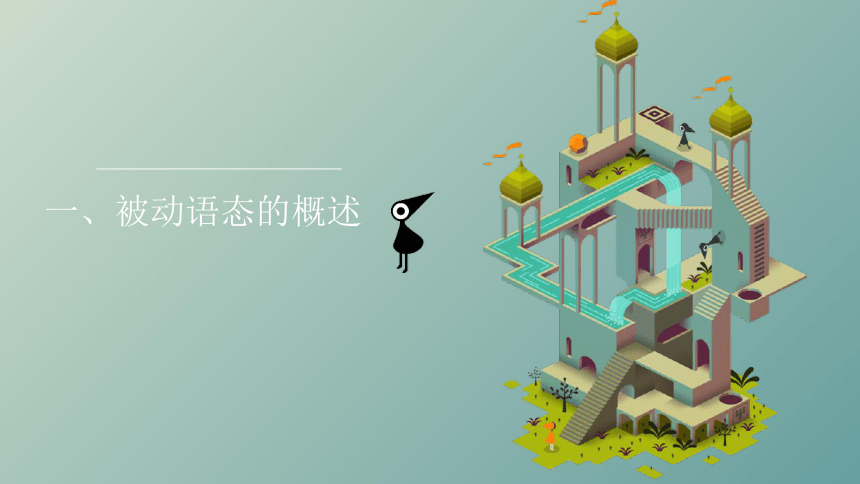
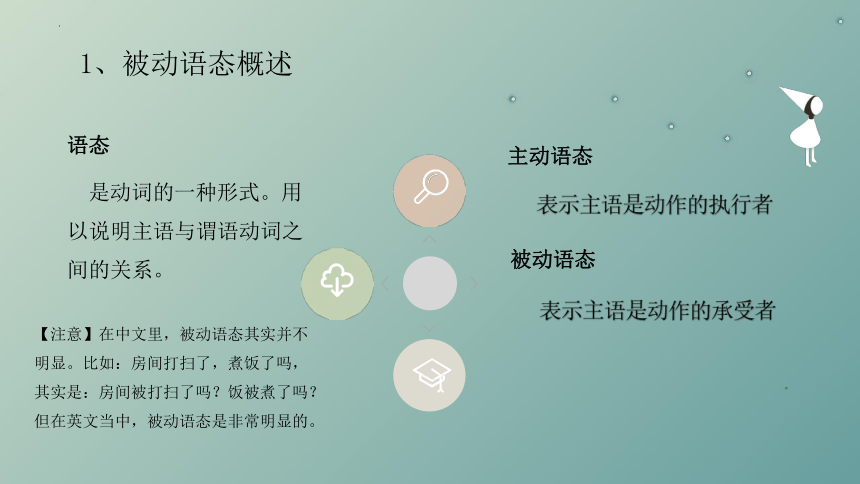
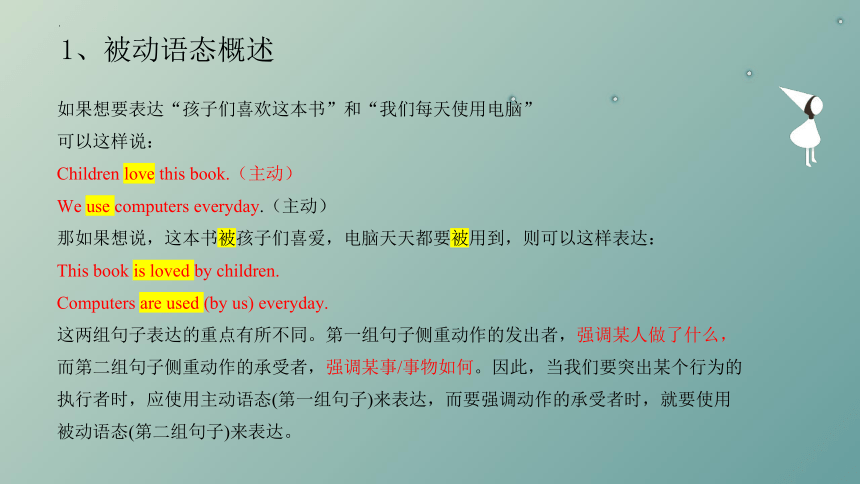
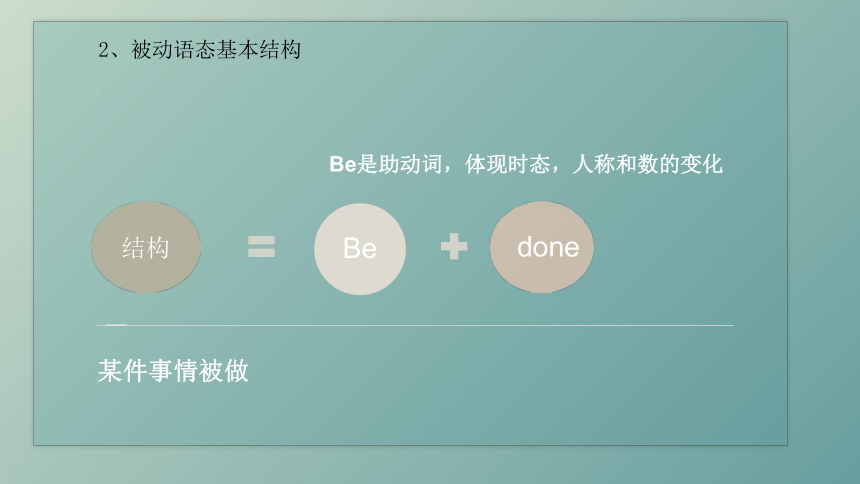



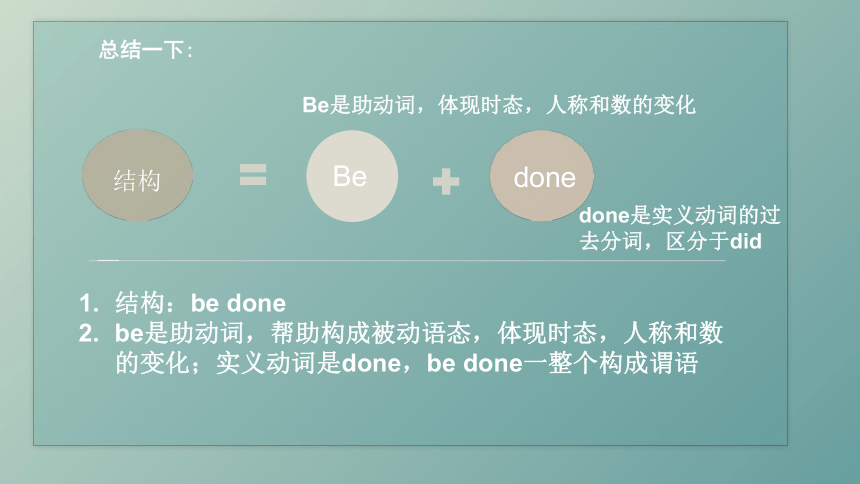
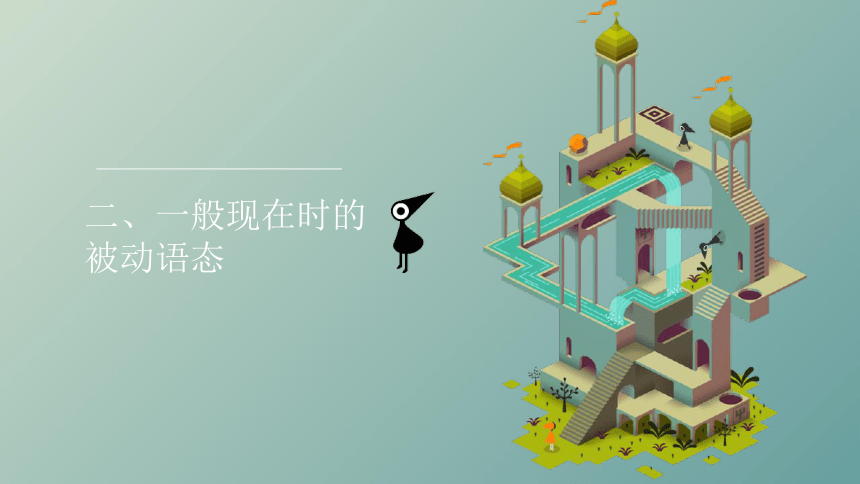
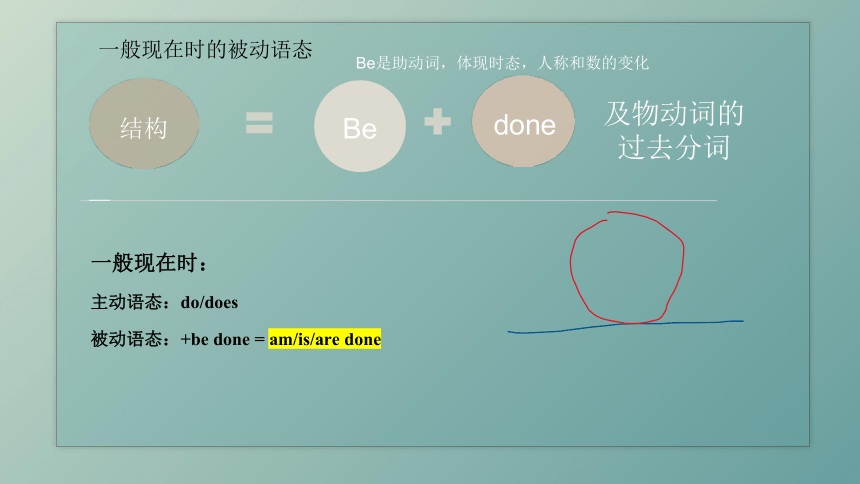
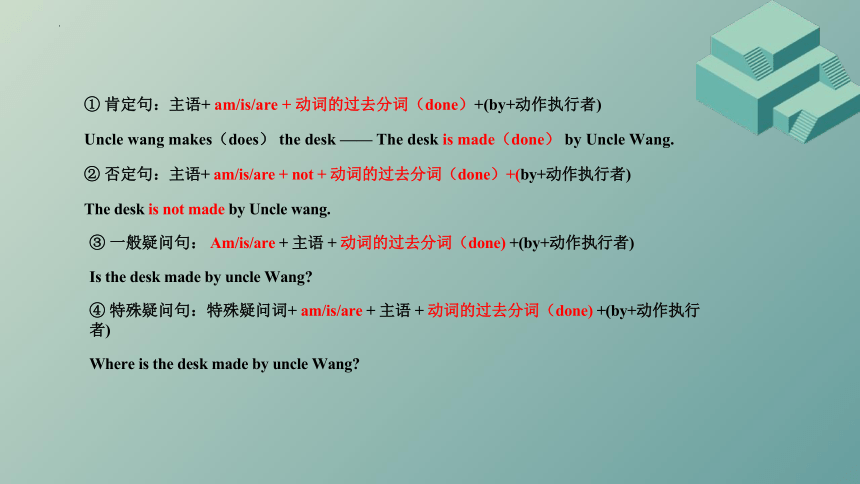
文档简介
(共30张PPT)
2024 中考语法(外研初三上)
——被动语态
一、被动语态的概述
语态
是动词的一种形式。用以说明主语与谓语动词之间的关系。
1、被动语态概述
主动语态
被动语态
。
【注意】在中文里,被动语态其实并不明显。比如:房间打扫了,煮饭了吗,其实是:房间被打扫了吗?饭被煮了吗?
但在英文当中,被动语态是非常明显的。
1、被动语态概述
如果想要表达“孩子们喜欢这本书”和“我们每天使用电脑”
可以这样说:
Children love this book.(主动)
We use computers everyday.(主动)
那如果想说,这本书被孩子们喜爱,电脑天天都要被用到,则可以这样表达:
This book is loved by children.
Computers are used (by us) everyday.
这两组句子表达的重点有所不同。第一组句子侧重动作的发出者,强调某人做了什么,而第二组句子侧重动作的承受者,强调某事/事物如何。因此,当我们要突出某个行为的执行者时,应使用主动语态(第一组句子)来表达,而要强调动作的承受者时,就要使用被动语态(第二组句子)来表达。
done
结构
Be
2、被动语态基本结构
Be是助动词,体现时态,人称和数的变化
某件事情被做
2.1 be动词是助动词:
We cleaned(过去式) the room.
S Vt O
The room was cleaned (by us). 房间被打扫。 Be done
S V
以前我们学be动词,是系动词。可以翻译成:是…..。
比如:she is beautiful. 她是漂亮的。I am a student.我是一个学生。
在这里是be done,是:被做的意思。所以真正的谓语,还是动词: “做”,前面这个be只是一个
助动词,帮助实义动词构成被动语态;
2. 可以联动到现在完成时:have/has done. 比如:I have learned English for fifteen years. 那这里的
这个have你不能把它翻译成:有,它也是一个助动词,帮助实义动词learn构成了完成时态。
2.2 被动即完整(间宾被动除外):
We cleaned the room. 我们打扫房间
S Vt O
The room was cleaned (by us). 房间被我们打扫=房间被打扫
S V
被动即完整。说完被动,句子意思已经完整了,后面跟不跟“被谁”已经不重要了。
3、转换图示:
将主动句的宾语变为主语
将动词改为"be+过去分词"(注意:遵循时态一致的原则)
将主动语态的主语放在介词by之后作宾语
这里的第一个planted是did,第二个planted是done。(注意区分did和done)
(make/made/made=ABB模式,cut/cut/cut=AAA模式,Become/became/become=ABA模式,begin/began/begun=ABC模式)
done
结构
Be
总结一下:
Be是助动词,体现时态,人称和数的变化
结构:be done
be是助动词,帮助构成被动语态,体现时态,人称和数的变化;实义动词是done,be done一整个构成谓语
done是实义动词的过
去分词,区分于did
二、一般现在时的被动语态
done
结构
Be
及物动词的过去分词
一般现在时的被动语态
一般现在时:
主动语态:do/does
被动语态:+be done = am/is/are done
Be是助动词,体现时态,人称和数的变化
① 肯定句:主语+ am/is/are + 动词的过去分词(done)+(by+动作执行者)
Uncle wang makes(does) the desk —— The desk is made(done) by Uncle Wang.
② 否定句:主语+ am/is/are + not + 动词的过去分词(done)+(by+动作执行者)
The desk is not made by Uncle wang.
③ 一般疑问句: Am/is/are + 主语 + 动词的过去分词(done) +(by+动作执行者)
Is the desk made by uncle Wang
④ 特殊疑问句:特殊疑问词+ am/is/are + 主语 + 动词的过去分词(done) +(by+动作执行者)
Where is the desk made by uncle Wang
Every time Tim a question, he just keeps silent.
Was asked B. is asked C. was asking D. asked
2. The ties are very nice. Get one for me before they .
sell out B. are sold C. sold out D. are sold out
3. In China money to children for good luck by their parents or other seniors in Spring Festival.
Gives B.is given C. are given D.give
4.Today Chinese by more and more people around the world.
Speak B. spoken C.is spoken D. speaks
5.Nobody should .
A. Laugh at B. be laughed C. be laughed at D. Laughed
6.Dr. Bethune still in both China and Canada today.
is, remembered B is, remembering C .will, remember D .has, remembered(has done)
7.-These days, teenagers often have to do what they to.
It‘s not good for their independence(独立). They need to think on their own.
A. tell B. are telling C. are told D. were told
8. The baby by the nurse in the hospital. Be done
looks after B. is looking after C. is looked after D. has looked after
9. Wechat is a tool which people to talk to others online.
A is used by B.is used to C. used to D. used for
10. The Dragon Boat Race every year on the Dragon Boat Festival in southern in China
Holds B. is held D. is holding C.was hold
11. -What a nice watch it is!
It's my birthday present. It Japan.
A. make in B. is made in C. is making in D.is made by
12.Young trees in the city every spring.
are planted B. were planted C. plant D. planted
三、一般过去时的被动语态
done
结构
Be
及物动词的过去分词
一般过去时的被动语态
一般过去时:
主动语态:did
被动语态:+ be done = was/were done
Be是助动词,体现时态,人称和数的变化
① 肯定形式为“主语+ was/ were + done +其他.”。当主语是动作的承受者,且是过去发生的动作时,就可采用这一结构。
【例】Tea was discovered a long time ago.
茶叶是在很久以前被发现的。
② 否定形式为“主语+ was/were+ not+ done +其他.”。 was not可缩写成wasn't, were not可缩写成weren't。
【例】 The helicopter wasn't invented by Fisher.
直升机不是由Fisher发明的。
四、一般将来时的被动语态
done
结构
Be
及物动词的过去分词
一般过去时的被动语态
一般将来时:
主动语态:will do/ be going to do
被动语态:will be done/ be going to be done
Be是助动词,体现时态,人称和数的变化
各种时态的被动语态
(以do为例)
时态 主动语态 被动语态
一般现在时 do/ does am/is/are done
一般过去时 did was/ were done
一般将来时 will do/ be going to do will be done/ be going to be done
现在进行时 am/is/are+ doing am/ is/ are being +done
过去进行时 was/were+ doing was/ were being +done
现在完成式 have/has+ done have/ has been + done
被动语态:be done
五、不用于被动语态的情形
1. 只有及物动词才有被动语态,不及物动词没有被动语态
及物动词是什么? 如果动词后面可以直接跟宾语,我们就称之为:及物动词。
因为不及物动词没有宾语,所以若将其用于被动语态则没有主语,故不能用于被动语态。
比如:
we cleaned the room. (在这里,clean是及物动词,宾语是the room)
变为被动:the room was cleaned by us. (将宾语the room调到被动句子中充当主语)
Time flys. (时间飞逝,在这里fly是不及物动词)
若想变为被动,这个句子没有宾语,那被动是不是就没有主语了?
因此,只有及物动词才有被动语态。
2. 某些静态动词没有被动语态
英语有些静态动词(如have, lack, fit, hold, suit, resemble等)通常不用于被动语态,如以下各句均不能变为被动语态。如:
My shoes don't fit me.
我的鞋不合适。
The young man lacks experience.
这个年轻人缺乏经验。
The hall holds 1000 people.
大厅可容纳1000人。
总结:被动语态
什么是被动语态?
突出动作的承受者(把主动语态当中的宾语提前了)
2. 结构:be(助动词,体现人称、数、时态的变化) + done(实义动词的过去分词)
3. 语态和时态在谓语动词中被体现,每种时态都有其对应的被动语态
一般现在时:主动:do/does 被动:am/is/are + done
一般过去时:主动:did 被动:was/ were + done
一般将来时:主动:will do/ be going to do 被动:will be done/ be going to be done
4. 只有及物动词才有被动语态
5. 区分did和done
解题步骤:
找到主语和谓语动词
判断它们之间的关系,是被动就要用be done
注意时态和人称,数的变化,再选择对应形式的被动语态
单项选择
六、 综合练习
词汇运用
1.—These plans are all nice. I haven't decided which one to choose. —It's OK.
You plenty of time to decide.
A. gave B. were given C. will give D. will be given
2. —What a beautiful garden! And clean, too!
—Yes, it every day.
A. cleans B. cleaned C. is cleaned D. was cleaned
3.Every year, a large amount of food all over the world. We need to do something to prevent it.
A. wastes B. wasted C. is wasted D. has wasted
例题——单项选择
例题——单项选择
( )4.A new hospital in my town next year.
A.builds B.built C.is built D.will be built
( )5.When Tim why he was late for school,he just kept silent.
A.was asked B.asked C.was asking D.is asked
( )6.I can’t understand what the book is about because it in English. A.writes B.will write C.will be written D.is written
例题——单项填空
6. Jane was almost (drive) mad by the noise next door.
Orange juice (offer) when I stayed at the hotel.
The school-leavers’ party (hold)after the final exam soon.
Never break school rules, or you’ll (punish).
A number of trees (plant) last year.
Nowadays, our whole life (record) online through all kinds of digital devices. (数码设备)
was offered
will be held
be punished
driven
were planted
is recorded
Thank you
2024 中考语法(外研初三上)
——被动语态
一、被动语态的概述
语态
是动词的一种形式。用以说明主语与谓语动词之间的关系。
1、被动语态概述
主动语态
被动语态
。
【注意】在中文里,被动语态其实并不明显。比如:房间打扫了,煮饭了吗,其实是:房间被打扫了吗?饭被煮了吗?
但在英文当中,被动语态是非常明显的。
1、被动语态概述
如果想要表达“孩子们喜欢这本书”和“我们每天使用电脑”
可以这样说:
Children love this book.(主动)
We use computers everyday.(主动)
那如果想说,这本书被孩子们喜爱,电脑天天都要被用到,则可以这样表达:
This book is loved by children.
Computers are used (by us) everyday.
这两组句子表达的重点有所不同。第一组句子侧重动作的发出者,强调某人做了什么,而第二组句子侧重动作的承受者,强调某事/事物如何。因此,当我们要突出某个行为的执行者时,应使用主动语态(第一组句子)来表达,而要强调动作的承受者时,就要使用被动语态(第二组句子)来表达。
done
结构
Be
2、被动语态基本结构
Be是助动词,体现时态,人称和数的变化
某件事情被做
2.1 be动词是助动词:
We cleaned(过去式) the room.
S Vt O
The room was cleaned (by us). 房间被打扫。 Be done
S V
以前我们学be动词,是系动词。可以翻译成:是…..。
比如:she is beautiful. 她是漂亮的。I am a student.我是一个学生。
在这里是be done,是:被做的意思。所以真正的谓语,还是动词: “做”,前面这个be只是一个
助动词,帮助实义动词构成被动语态;
2. 可以联动到现在完成时:have/has done. 比如:I have learned English for fifteen years. 那这里的
这个have你不能把它翻译成:有,它也是一个助动词,帮助实义动词learn构成了完成时态。
2.2 被动即完整(间宾被动除外):
We cleaned the room. 我们打扫房间
S Vt O
The room was cleaned (by us). 房间被我们打扫=房间被打扫
S V
被动即完整。说完被动,句子意思已经完整了,后面跟不跟“被谁”已经不重要了。
3、转换图示:
将主动句的宾语变为主语
将动词改为"be+过去分词"(注意:遵循时态一致的原则)
将主动语态的主语放在介词by之后作宾语
这里的第一个planted是did,第二个planted是done。(注意区分did和done)
(make/made/made=ABB模式,cut/cut/cut=AAA模式,Become/became/become=ABA模式,begin/began/begun=ABC模式)
done
结构
Be
总结一下:
Be是助动词,体现时态,人称和数的变化
结构:be done
be是助动词,帮助构成被动语态,体现时态,人称和数的变化;实义动词是done,be done一整个构成谓语
done是实义动词的过
去分词,区分于did
二、一般现在时的被动语态
done
结构
Be
及物动词的过去分词
一般现在时的被动语态
一般现在时:
主动语态:do/does
被动语态:+be done = am/is/are done
Be是助动词,体现时态,人称和数的变化
① 肯定句:主语+ am/is/are + 动词的过去分词(done)+(by+动作执行者)
Uncle wang makes(does) the desk —— The desk is made(done) by Uncle Wang.
② 否定句:主语+ am/is/are + not + 动词的过去分词(done)+(by+动作执行者)
The desk is not made by Uncle wang.
③ 一般疑问句: Am/is/are + 主语 + 动词的过去分词(done) +(by+动作执行者)
Is the desk made by uncle Wang
④ 特殊疑问句:特殊疑问词+ am/is/are + 主语 + 动词的过去分词(done) +(by+动作执行者)
Where is the desk made by uncle Wang
Every time Tim a question, he just keeps silent.
Was asked B. is asked C. was asking D. asked
2. The ties are very nice. Get one for me before they .
sell out B. are sold C. sold out D. are sold out
3. In China money to children for good luck by their parents or other seniors in Spring Festival.
Gives B.is given C. are given D.give
4.Today Chinese by more and more people around the world.
Speak B. spoken C.is spoken D. speaks
5.Nobody should .
A. Laugh at B. be laughed C. be laughed at D. Laughed
6.Dr. Bethune still in both China and Canada today.
is, remembered B is, remembering C .will, remember D .has, remembered(has done)
7.-These days, teenagers often have to do what they to.
It‘s not good for their independence(独立). They need to think on their own.
A. tell B. are telling C. are told D. were told
8. The baby by the nurse in the hospital. Be done
looks after B. is looking after C. is looked after D. has looked after
9. Wechat is a tool which people to talk to others online.
A is used by B.is used to C. used to D. used for
10. The Dragon Boat Race every year on the Dragon Boat Festival in southern in China
Holds B. is held D. is holding C.was hold
11. -What a nice watch it is!
It's my birthday present. It Japan.
A. make in B. is made in C. is making in D.is made by
12.Young trees in the city every spring.
are planted B. were planted C. plant D. planted
三、一般过去时的被动语态
done
结构
Be
及物动词的过去分词
一般过去时的被动语态
一般过去时:
主动语态:did
被动语态:+ be done = was/were done
Be是助动词,体现时态,人称和数的变化
① 肯定形式为“主语+ was/ were + done +其他.”。当主语是动作的承受者,且是过去发生的动作时,就可采用这一结构。
【例】Tea was discovered a long time ago.
茶叶是在很久以前被发现的。
② 否定形式为“主语+ was/were+ not+ done +其他.”。 was not可缩写成wasn't, were not可缩写成weren't。
【例】 The helicopter wasn't invented by Fisher.
直升机不是由Fisher发明的。
四、一般将来时的被动语态
done
结构
Be
及物动词的过去分词
一般过去时的被动语态
一般将来时:
主动语态:will do/ be going to do
被动语态:will be done/ be going to be done
Be是助动词,体现时态,人称和数的变化
各种时态的被动语态
(以do为例)
时态 主动语态 被动语态
一般现在时 do/ does am/is/are done
一般过去时 did was/ were done
一般将来时 will do/ be going to do will be done/ be going to be done
现在进行时 am/is/are+ doing am/ is/ are being +done
过去进行时 was/were+ doing was/ were being +done
现在完成式 have/has+ done have/ has been + done
被动语态:be done
五、不用于被动语态的情形
1. 只有及物动词才有被动语态,不及物动词没有被动语态
及物动词是什么? 如果动词后面可以直接跟宾语,我们就称之为:及物动词。
因为不及物动词没有宾语,所以若将其用于被动语态则没有主语,故不能用于被动语态。
比如:
we cleaned the room. (在这里,clean是及物动词,宾语是the room)
变为被动:the room was cleaned by us. (将宾语the room调到被动句子中充当主语)
Time flys. (时间飞逝,在这里fly是不及物动词)
若想变为被动,这个句子没有宾语,那被动是不是就没有主语了?
因此,只有及物动词才有被动语态。
2. 某些静态动词没有被动语态
英语有些静态动词(如have, lack, fit, hold, suit, resemble等)通常不用于被动语态,如以下各句均不能变为被动语态。如:
My shoes don't fit me.
我的鞋不合适。
The young man lacks experience.
这个年轻人缺乏经验。
The hall holds 1000 people.
大厅可容纳1000人。
总结:被动语态
什么是被动语态?
突出动作的承受者(把主动语态当中的宾语提前了)
2. 结构:be(助动词,体现人称、数、时态的变化) + done(实义动词的过去分词)
3. 语态和时态在谓语动词中被体现,每种时态都有其对应的被动语态
一般现在时:主动:do/does 被动:am/is/are + done
一般过去时:主动:did 被动:was/ were + done
一般将来时:主动:will do/ be going to do 被动:will be done/ be going to be done
4. 只有及物动词才有被动语态
5. 区分did和done
解题步骤:
找到主语和谓语动词
判断它们之间的关系,是被动就要用be done
注意时态和人称,数的变化,再选择对应形式的被动语态
单项选择
六、 综合练习
词汇运用
1.—These plans are all nice. I haven't decided which one to choose. —It's OK.
You plenty of time to decide.
A. gave B. were given C. will give D. will be given
2. —What a beautiful garden! And clean, too!
—Yes, it every day.
A. cleans B. cleaned C. is cleaned D. was cleaned
3.Every year, a large amount of food all over the world. We need to do something to prevent it.
A. wastes B. wasted C. is wasted D. has wasted
例题——单项选择
例题——单项选择
( )4.A new hospital in my town next year.
A.builds B.built C.is built D.will be built
( )5.When Tim why he was late for school,he just kept silent.
A.was asked B.asked C.was asking D.is asked
( )6.I can’t understand what the book is about because it in English. A.writes B.will write C.will be written D.is written
例题——单项填空
6. Jane was almost (drive) mad by the noise next door.
Orange juice (offer) when I stayed at the hotel.
The school-leavers’ party (hold)after the final exam soon.
Never break school rules, or you’ll (punish).
A number of trees (plant) last year.
Nowadays, our whole life (record) online through all kinds of digital devices. (数码设备)
was offered
will be held
be punished
driven
were planted
is recorded
Thank you
同课章节目录
- 词法
- 名词
- 动词和动词短语
- 动词语态
- 动词时态
- 助动词和情态动词
- 非谓语动词
- 冠词
- 代词
- 数词和量词
- 形容词副词及其比较等级
- 介词和介词短语
- 连词和感叹词
- 构词法
- 相似、相近词比较
- 句法
- 陈述句
- 一般疑问句和否定疑问句
- 特殊疑问句及选择疑问句
- 反意疑问句
- 存在句(There be句型)
- 宾语从句
- 定语从句
- 状语从句
- 主谓一致问题
- 简单句
- 并列句
- 复合句
- 主谓一致
- 主、表语从句
- 名词性从句
- 直接引语和间接引语
- 虚拟语气
- 感叹句
- 强调句
- 倒装句
- 祈使句
- 句子的成分
- 句子的分类
- 题型专区
- 单项选择部分
- 易错题
- 完形填空
- 阅读理解
- 词汇练习
- 听说训练
- 句型转换
- 补全对话
- 短文改错
- 翻译
- 书面表达
- 任务型阅读
- 语法填空
- 其他资料
